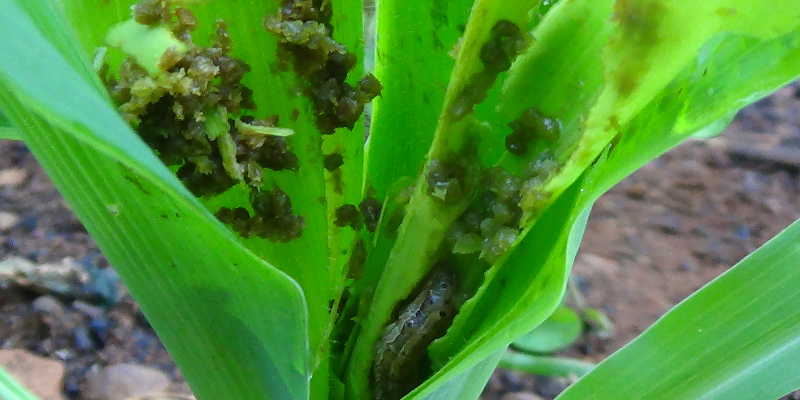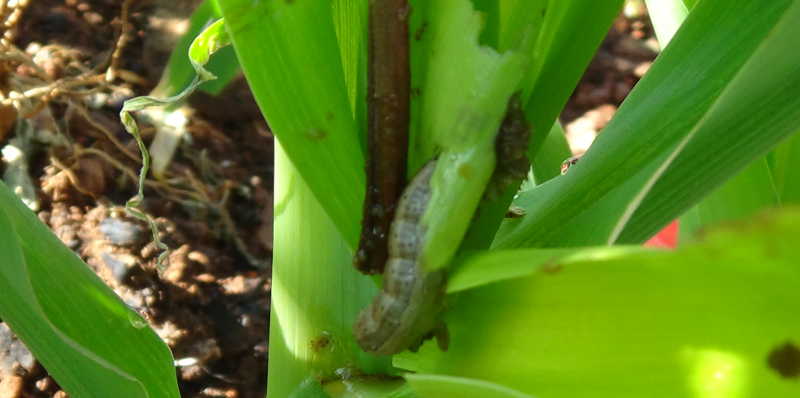Guest Writer
A shocking encounter with fall army-worms

The monster hides deep in the head of the maize crop that it’s hardly visible during day. It ressufaces at night to devour the host
About a week ago, my wife Esther brought my attention to an attack in our little maize garden. She urged me to spray the tender plants having detected damage on the leaves on the crop that is just three weeks now.
I hesitantly accepted to spray against the feeling that it was a bit too early to spray the crops that are barely a month. I am used to spraying the maize when it’s about two metres or six weeks. On insistence by Esther I sprayed the maize on Wednesday 15 using Cypermethrin, a common pesticide we have used for years to control the maize stem borers.
On Saturday, three days after I sprayed, I checked the crops and discovered that the damage was progressing unabated, as if no spraying had been done. Anxiety set in. I moved closer to the plants and all of a sudden realised the damage was serious. For some badly affected plants, the pest had inflicted significant damage and moved on to fresh plants.
I started hunting for the enemy pest. But they were not easily visible. Desperation pushed me to look harder. I noticed something akin to a caterpillar buried right deep in the head of the plant.
Ouch! It was a huge larvae, much bigger than the common stem borers we’ve always known. My neighbour Mr. James Kawesi, a Commissioner in the Ministry of Water stopped by when he saw me inspecting the crops. He too expressed concern that the tender crops had been affected so early.
I showed him the monster caterpillar that I had hunted. He was equally shocked. We got to the conclusion that we were certainly witnessing something new. He added that he had watched a news item on TV about farmers somewhere in Luwero who were lamenting about a similar attack.
Fortunately, because of my profession, I had known about an outbreak of a new more pervasive, invasive and devastating worm called a fall army-worm in Kasese, and other South Western Uganda districts a few weeks ago. It had never crossed my mind it could reach us so fast, especially since we are not surrounded by maize growers.
I called Mr. Stephen Ochen, a maize breeder who I had spoken with for a similar article recently to described to him what I had seen. He fretted that they could actually be the dreaded army-worms that are spreading rapidly across the country. He told me the caterpillars actually grow very big and do not die from common pesticides.
He had told me of a certain pesticide with a mouthful of a name; Chlobeson Emamectin Benzoate 5 that was used by farmers in Kasese to control the pest – actually before it was confirmed by NARO experts.
I hit Container Village in Kampala, (Uganda’s hub for agricultural supplies) about an hour after detecting the caterpillars in our little garden. Most people had no clue about the Benzoate stuff. I proceeded to Bukoola Chemicals shop, one of the most reputable in town for advice.
An agriculturalist on hand to advise farmers directed me to buy Dudu Fenos 440, as the remedy. In a few minutes of waiting for my order, three different farmers, one from Isingiro western Uganda, another from Matugga in Wakiso, and another who didn’t want to reveal his details, reported a similar problem and were advised accordingly.
In a casual conversation I opened with Jimmy Kayambe from Isingiro and Hamza Kintu from Matugga, they gave me some assurance that Bukoola’s chemical had been used successfully to control the pest.
I however realised the country faces a serious and urgent problem, one that will not only cost farmers dearly in terms of expenses in spraying, but also in reduced production arising from damage.
Kayambe for instance, who lives in Kampala and employs people to work on his garden back in Isingiro, told me his workers had tried to spray several chemicals but in vain.
“In one week, the caterpillars have eaten three acres,” Kayambe told me. “But the larvae will probably grow into butterfly in a few days,” he added. But Kintu interjected by saying that considering the rate of damage, by the time they grow into pupae, extensive damage would have been done.
In fact, if data on scientific websites such as Purdue university (ension.entm.purdue.edu) are anything to go by, Kayambe is mistaken. The army-worm larvae has a lifespan of close to three months, nearly the lifespan of a maize crop. If it can eat three acres in a week, imagine three months when the monster larvae will have grown bigger.
I may be one of the lucky Ugandans to access some chemical at this stage in the season. But I suspect that demand will soon outpace supply by Bukoola or that the black market of more expensive, or fake products is going to emerge more to the detriment of farmers.
Even more worrying, perhaps is that, the application of the chemical is likely to be quite cumbersome for some large-scale maize farmers.
As Bukoola’s extension advisor revealed to us, one has to ensure the chemical is sprayed in the funnel of the maize so that the chemical gets into contact with the caterpillars that hide deep in the head of the crop during the day. As I observed, the pest has a way it evades its predators like birds and enemies like us humans or the scotching sun. And, as we were advised, the spraying has to be done at once every week for three weeks.
The invasion of highly destructive pests comes hot on the heals of a year long drought that caused widespread damage to crops and starvation in Uganda.
One wonders though, if the country can attain its goal of moving from least developed to lower middle income economy status in 2020 with the recurrent setbacks to production and productivity.
Scientists say they have a solution to these marauding pests in shape of a resistant variety that not only stands up to the fall armyworm, but also to the similar worms such as the stem borer. They complain however that politicians and NGOs mostly from Europe are blocking us farmers from accessing the potentially life-saving crops. Why? It’s a question Politicians do not want to answer.
I am left thinking that if as a society we have looked to science to solve some of the most pressing problems such as diseases like Measles, Polio, HIV/AIDS, Tuberculosis and Malaria, what’s stopping us from taking a similar approach by trying to find a vaccine for crops or enhancing their resistance to harsh weather, especially in an era of climate change where we are certain these shocks will be the norm?
Comments






















